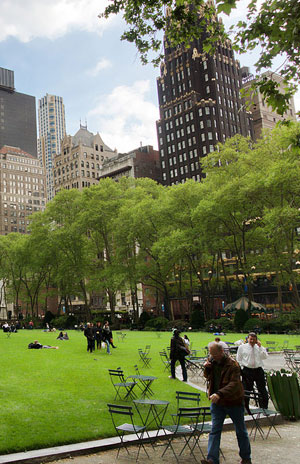Urban Trees Save Lives
A recent study by urban forestry guru David Nowak and other researchers at U.S. Forest Service and The Davey Institute found that urban trees save at least one life per year in most cities and up to 8 people per year in large metropolises like New York City.
"Trees growing in cities help clean the air of fine particulate air pollution — soot, smoke, dust, dirt — that can lodge in human lungs and cause health problems," Grist explains. As an example, "trees clear 71 tons" of air particulate matter 2.5 micrometers in diameter (PM2.5) from Atlanta's air each year.
As explained in a recent post on outdoor air pollution, urban particulate air pollution kills as many as 2.5 million people each year. PM 2.5 has a drastic effect on human health, including premature mortality.
Researchers noted that larger particles between particulates 2.5 to 10 micrometers in diameter—also called coarse dust particles or PM10—are removed by trees at a substantially higher rate. However, the health benefits of PM2.5 removal is 30 to 350 times more valuable.
What happens to our health when those trees die from natural causes en masse? Apparently, as another recent study claims, people die, too. This study study showed that the "loss of trees to the emerald ash borer increased mortality related to cardiovascular and lower-respiratory-tract illness. This finding adds to the growing evidence that the natural environment provides major public health benefits." Untrammeled development would then also have the same negative health impacts at the ash borer.
Of course, the health benefits are not restricted to our lungs and heart, but also our minds. As can be seen in a new UK-wide study, parks, gardens, and even street trees in urban areas improve the mood and mental well-being of the surrounding residents.
The value of trees goes well beyond their immediate air quality-reducing properties, too. According to one recent U.S. Forest Service study, "urban forests are responsible for storing 708 million tons of carbon—a service valued at $50 billion."
Not to ignore the financial side of better health, the Nowak study also claims that "the average health benefits value per hectare of tree cover was about $1,600, but varied [from city to city]."
The study concludes that "trees can produce substantial health improvements and values in cities." Although more research is needed to improve these estimates, this study also leaves room for new research that explores the local effects of tree-filled landscapes in cities.
This guest post is by Phil Stamper, ASLA PR and Communications Coordinator.
Image credit: Bryant Park, NYC / Wikipedia


